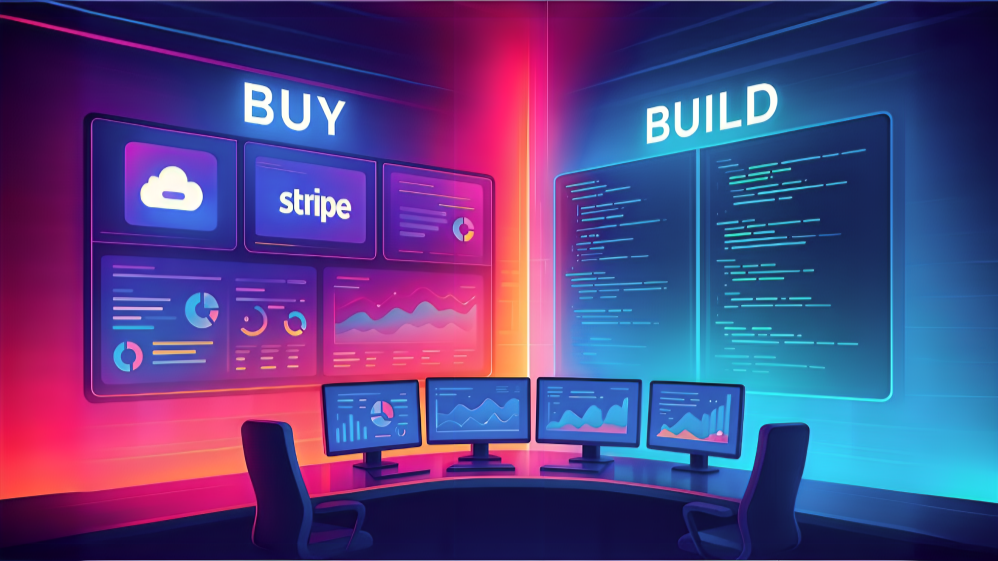AI productivity tools have moved from “nice-to-have” to business-critical almost overnight. In 2024, 92% of companies reported ramping up AI adoption, with generative AI now woven into daily workflows (TechTarget). The results are hard to ignore: customer support teams boosted productivity by 14% with AI assistance (PYMNTS), and software engineers at JPMorgan Chase saw efficiency gains of up to 20% (X-Team). In controlled trials, developers using AI pair programmers completed tasks 55.8% faster (Finxter).
With 70% of workers eager to hand off as much as possible to AI (Microsoft WorkLab), leaders are under pressure to act fast. But there’s a catch: the build-or-buy decision is now a high-stakes strategic move, not just a procurement formality. The wrong choice can drain resources and erode your competitive edge (Workflow Guide).
Generative AI has upended old assumptions—building and buying are both faster and more accessible than ever (X-Team; CSauerborn). Your next move will shape your team’s productivity for years to come.
There’s no one-size-fits-all. Here’s what to weigh before you commit:
Building in-house isn’t cheap. Expect $500,000 to $1M+ up front, plus months (or years) of development and ongoing support (Workflow Guide). Maintenance, upgrades, and talent retention add to the bill—and are often underestimated (Techronicler).
Buying means lower up-front costs and predictable subscription fees, enabling rapid deployment. But beware hidden costs—premium features, scaling, and vendor lock-in can sneak up on you. Always run a full total cost of ownership (TCO) analysis, not just sticker price.
We are awfully close to AGI
— Bindu Reddy (@bindureddy) February 16, 2025
- AI code editors are writing 50% of the code
- tasks and agents are automating workflows
- operator can automate workflows
- deep research automates knowledge work
In a few more months, we will solve the last mile problem in AI and the early…
Building requires deep expertise—data science, ML engineering, DevOps, UX. If you don’t have a proven AI team, expect delays and risk of failure (Techronicler). Recruiting or upskilling is expensive and time-consuming.
If you already have top-tier AI talent or proprietary know-how, building can give you a competitive edge. Otherwise, buying or partnering is often the pragmatic path.
Sensitive data demands control. Building in-house gives you full authority over security and compliance (GDPR, HIPAA, etc.) (Techronicler). Buying means trusting a vendor—acceptable for many, but risky for regulated industries or proprietary information.
Reputable vendors invest in security and promise not to use your data for model training (Reuters), but due diligence is non-negotiable. If your use case relies on unique or confidential data, building is often the safer route.
Buying gets you operational in days or weeks (Workflow Guide). Building takes months or more. In fast-moving markets, delays mean lost ground (Techronicler).
That said, modern APIs and frameworks have collapsed timelines—what took six months now takes two weeks for a proof of concept (X-Team). For most teams, starting with an off-the-shelf tool to validate use cases is the smart move.
Commercial tools are designed for broad use. If your needs are unique or you require deep integration with internal systems, building gives you full control (Techronicler). For standard productivity tasks, off-the-shelf solutions are usually sufficient and more cost-effective (LinkedIn).

To avoid vendor lock-in, negotiate for data portability and open integrations—or consider hybrid models that combine vendor AI with custom-built layers (CSauerborn).
Building means you own scaling, updates, and performance tuning (Techronicler). Underinvest here, and you risk technical debt and declining ROI.
Buying shifts maintenance and scaling to the vendor, but you’re tied to their roadmap and reliability. Ensure any tool you choose can integrate with your stack and that the vendor is built to last.
Ask yourself: Is this AI capability core to your competitive advantage, or just a utility? If it’s mission-critical (think Bloomberg’s proprietary BloombergGPT for finance) (Mashable ME), building may be worth the investment. For general productivity, buying is often the smarter play (Techronicler). In short: build what sets you apart, buy what doesn’t.
“Build or buy” isn’t binary. Many teams start with a third-party tool for quick wins, then layer on custom extensions as needs evolve (Techronicler). Open-source models like LLaMA 2 can be fine-tuned in-house, offering a blend of flexibility and cost savings.
Hybrid approaches also include buying core technology (like the OpenAI API) and building custom interfaces or integrations internally (CSauerborn). This lets you deploy proven AI while tailoring it to your workflows.
Launching our latest quarterly Artificial Analysis State of AI Report: Our analysis of the key trends shaping AI
— Artificial Analysis (@ArtificialAnlys) May 20, 2025
A highlights version of the report is available for download on our website for a limited time.
We unpack 6 trends defining AI in early 2025:
1.⚡ The race for… pic.twitter.com/DLdOA2qf3J
Whatever your mix, keep building in-house skills. Even if you mostly buy, internal expertise is essential for evaluating and customizing solutions. The AI landscape shifts fast—what works today may be obsolete tomorrow (CSauerborn).
The build-or-buy choice is a strategic lever—not a checkbox. Start by mapping your goals and pain points. Score each option against the criteria above. For most teams, the fastest path is to pilot a third-party tool, capture quick wins, and then invest in custom development where it drives clear value.
Set clear success metrics, secure executive buy-in, and treat your AI strategy as a living process. Revisit your decision as technology and business needs evolve.
Your goal isn’t to “do AI”—it’s to empower your teams and drive measurable productivity. With a clear framework and sharp evaluation, you can make the right call and position your team to thrive in the AI-powered era.
Subscribe for weekly AI productivity insights.